BSBHRM513 Workforce Planning: Demand, Supply, Gap Analysis Report
VerifiedAdded on 2023/06/09
|6
|1529
|402
Homework Assignment
AI Summary
This assignment solution provides a detailed overview of workforce planning, focusing on demand and supply analysis. It defines demand analysis as determining the workforce needed to complete organizational tasks, emphasizing its role in calculating employee numbers based on past, present, and future trends. The solution identifies and describes techniques for demand analysis, including survey methods, sample survey methods, and end-use methods. It also addresses supply analysis, explaining its importance in matching workforce supply with demand, and discusses methods like trend analysis, competency models, and staffing tables. Furthermore, the assignment covers gap analysis, highlighting its utility in identifying areas for improvement and aligning resources with business requirements. The solution also touches on Wesfarmers' industrial relations policies and the significance of skilling, training, and social trends in workforce planning. Desklib provides students with access to this and other solved assignments to aid in their studies.
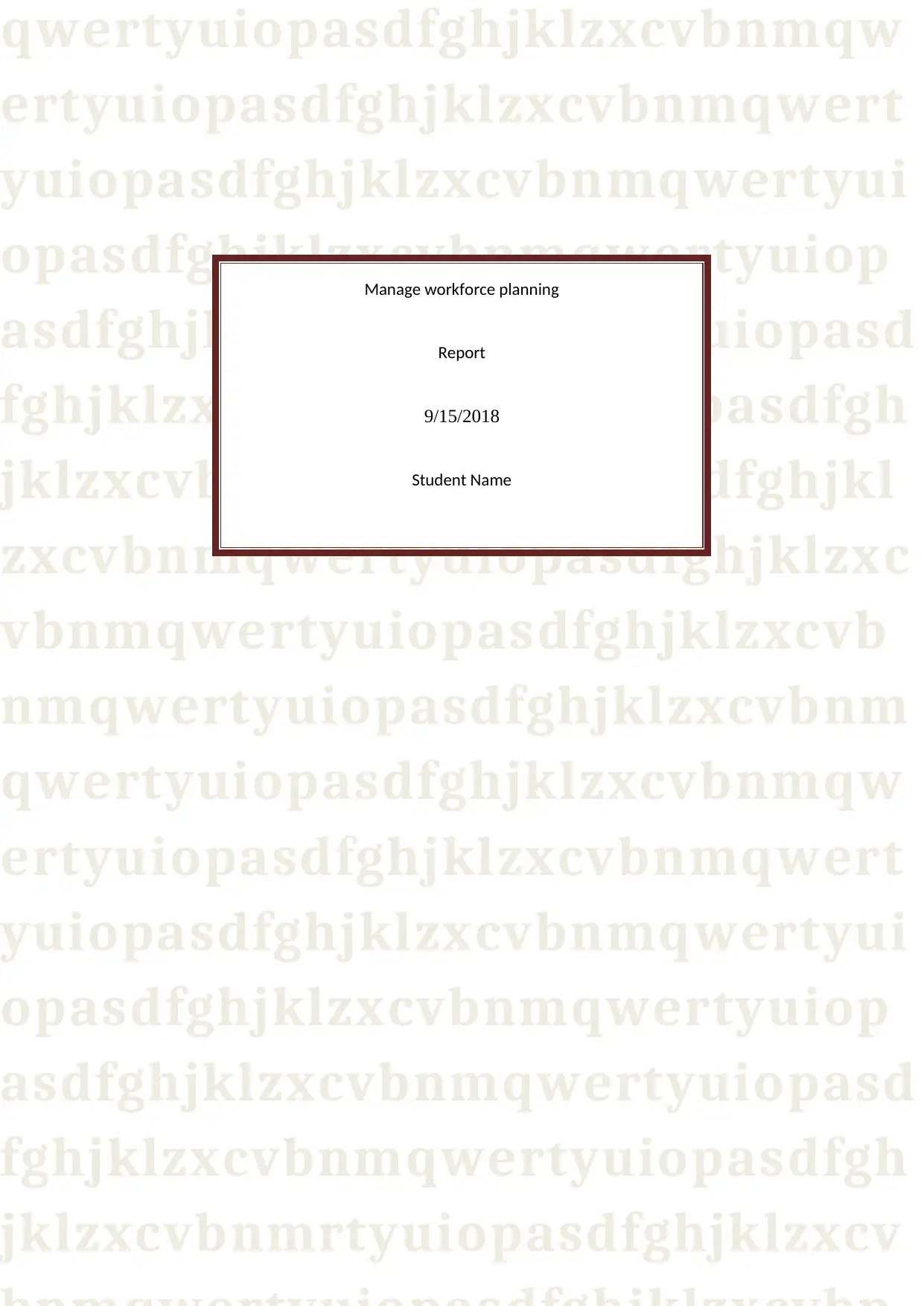
qwertyuiopasdfghjklzxcvbnmqw
ertyuiopasdfghjklzxcvbnmqwert
yuiopasdfghjklzxcvbnmqwertyui
opasdfghjklzxcvbnmqwertyuiop
asdfghjklzxcvbnmqwertyuiopasd
fghjklzxcvbnmqwertyuiopasdfgh
jklzxcvbnmqwertyuiopasdfghjkl
zxcvbnmqwertyuiopasdfghjklzxc
vbnmqwertyuiopasdfghjklzxcvb
nmqwertyuiopasdfghjklzxcvbnm
qwertyuiopasdfghjklzxcvbnmqw
ertyuiopasdfghjklzxcvbnmqwert
yuiopasdfghjklzxcvbnmqwertyui
opasdfghjklzxcvbnmqwertyuiop
asdfghjklzxcvbnmqwertyuiopasd
fghjklzxcvbnmqwertyuiopasdfgh
jklzxcvbnmrtyuiopasdfghjklzxcv
Manage workforce planning
Report
9/15/2018
Student Name
ertyuiopasdfghjklzxcvbnmqwert
yuiopasdfghjklzxcvbnmqwertyui
opasdfghjklzxcvbnmqwertyuiop
asdfghjklzxcvbnmqwertyuiopasd
fghjklzxcvbnmqwertyuiopasdfgh
jklzxcvbnmqwertyuiopasdfghjkl
zxcvbnmqwertyuiopasdfghjklzxc
vbnmqwertyuiopasdfghjklzxcvb
nmqwertyuiopasdfghjklzxcvbnm
qwertyuiopasdfghjklzxcvbnmqw
ertyuiopasdfghjklzxcvbnmqwert
yuiopasdfghjklzxcvbnmqwertyui
opasdfghjklzxcvbnmqwertyuiop
asdfghjklzxcvbnmqwertyuiopasd
fghjklzxcvbnmqwertyuiopasdfgh
jklzxcvbnmrtyuiopasdfghjklzxcv
Manage workforce planning
Report
9/15/2018
Student Name
Paraphrase This Document
Need a fresh take? Get an instant paraphrase of this document with our AI Paraphraser
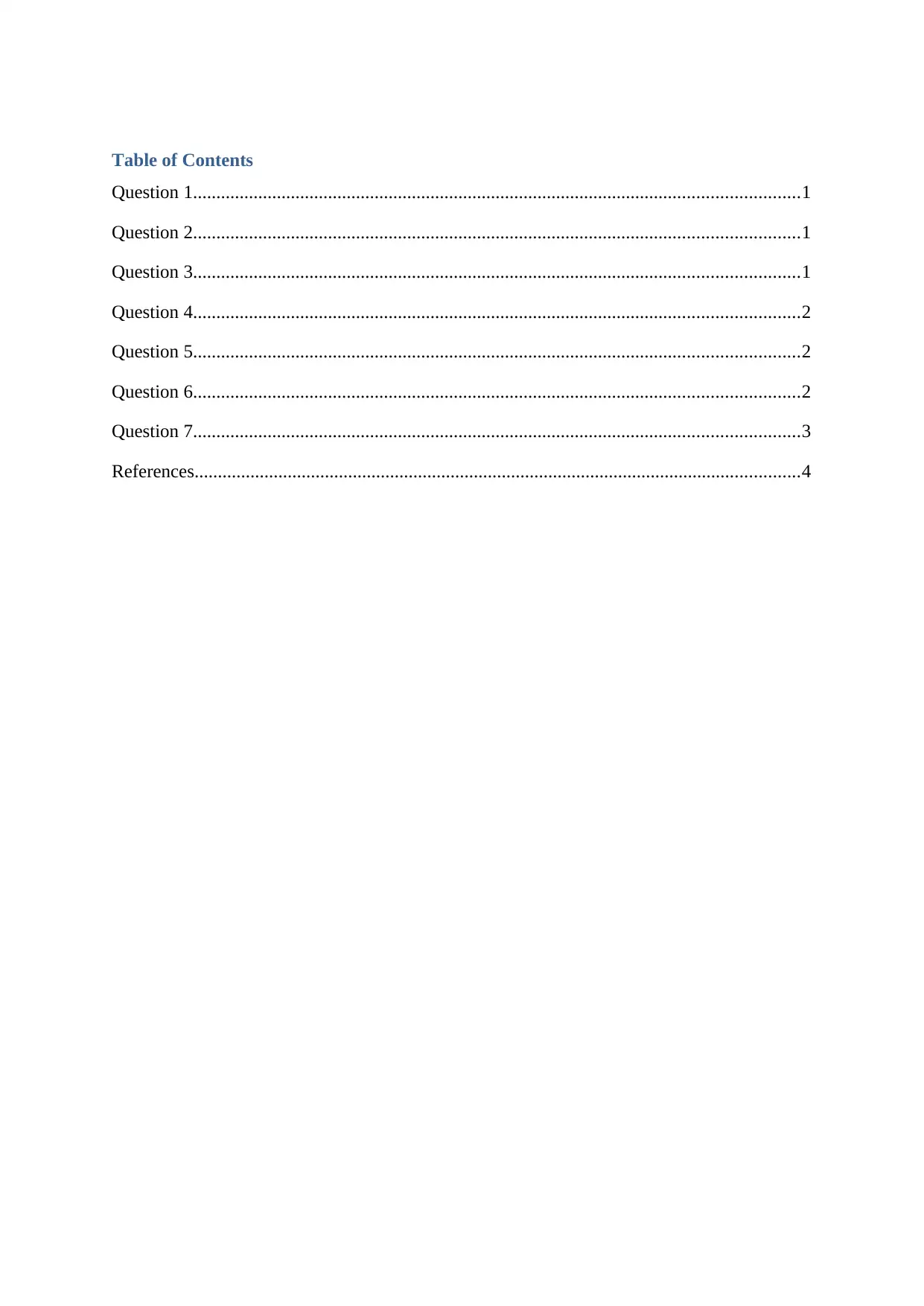
Table of Contents
Question 1..................................................................................................................................1
Question 2..................................................................................................................................1
Question 3..................................................................................................................................1
Question 4..................................................................................................................................2
Question 5..................................................................................................................................2
Question 6..................................................................................................................................2
Question 7..................................................................................................................................3
References..................................................................................................................................4
Question 1..................................................................................................................................1
Question 2..................................................................................................................................1
Question 3..................................................................................................................................1
Question 4..................................................................................................................................2
Question 5..................................................................................................................................2
Question 6..................................................................................................................................2
Question 7..................................................................................................................................3
References..................................................................................................................................4
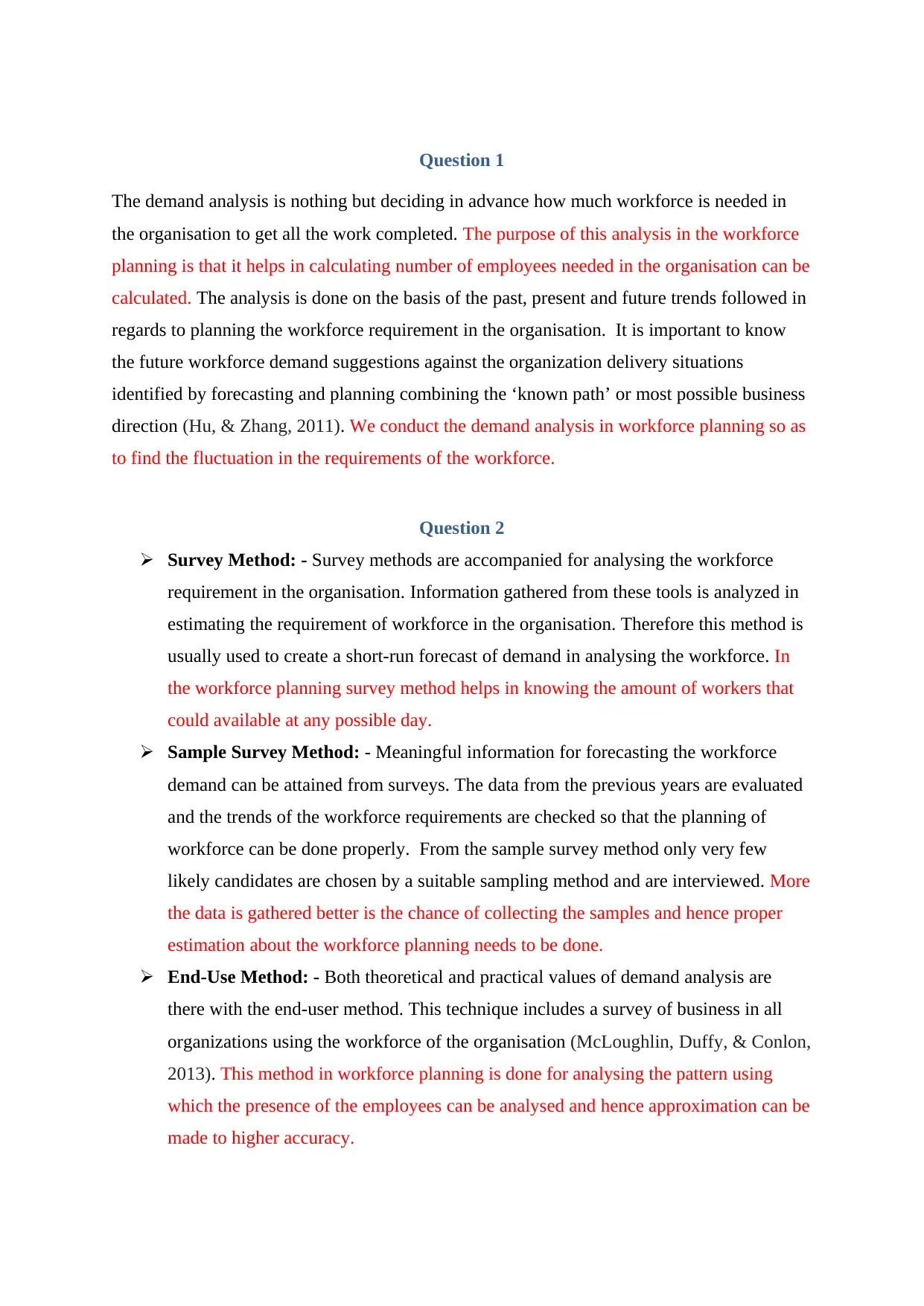
Question 1
The demand analysis is nothing but deciding in advance how much workforce is needed in
the organisation to get all the work completed. The purpose of this analysis in the workforce
planning is that it helps in calculating number of employees needed in the organisation can be
calculated. The analysis is done on the basis of the past, present and future trends followed in
regards to planning the workforce requirement in the organisation. It is important to know
the future workforce demand suggestions against the organization delivery situations
identified by forecasting and planning combining the ‘known path’ or most possible business
direction (Hu, & Zhang, 2011). We conduct the demand analysis in workforce planning so as
to find the fluctuation in the requirements of the workforce.
Question 2
Survey Method: - Survey methods are accompanied for analysing the workforce
requirement in the organisation. Information gathered from these tools is analyzed in
estimating the requirement of workforce in the organisation. Therefore this method is
usually used to create a short-run forecast of demand in analysing the workforce. In
the workforce planning survey method helps in knowing the amount of workers that
could available at any possible day.
Sample Survey Method: - Meaningful information for forecasting the workforce
demand can be attained from surveys. The data from the previous years are evaluated
and the trends of the workforce requirements are checked so that the planning of
workforce can be done properly. From the sample survey method only very few
likely candidates are chosen by a suitable sampling method and are interviewed. More
the data is gathered better is the chance of collecting the samples and hence proper
estimation about the workforce planning needs to be done.
End-Use Method: - Both theoretical and practical values of demand analysis are
there with the end-user method. This technique includes a survey of business in all
organizations using the workforce of the organisation (McLoughlin, Duffy, & Conlon,
2013). This method in workforce planning is done for analysing the pattern using
which the presence of the employees can be analysed and hence approximation can be
made to higher accuracy.
The demand analysis is nothing but deciding in advance how much workforce is needed in
the organisation to get all the work completed. The purpose of this analysis in the workforce
planning is that it helps in calculating number of employees needed in the organisation can be
calculated. The analysis is done on the basis of the past, present and future trends followed in
regards to planning the workforce requirement in the organisation. It is important to know
the future workforce demand suggestions against the organization delivery situations
identified by forecasting and planning combining the ‘known path’ or most possible business
direction (Hu, & Zhang, 2011). We conduct the demand analysis in workforce planning so as
to find the fluctuation in the requirements of the workforce.
Question 2
Survey Method: - Survey methods are accompanied for analysing the workforce
requirement in the organisation. Information gathered from these tools is analyzed in
estimating the requirement of workforce in the organisation. Therefore this method is
usually used to create a short-run forecast of demand in analysing the workforce. In
the workforce planning survey method helps in knowing the amount of workers that
could available at any possible day.
Sample Survey Method: - Meaningful information for forecasting the workforce
demand can be attained from surveys. The data from the previous years are evaluated
and the trends of the workforce requirements are checked so that the planning of
workforce can be done properly. From the sample survey method only very few
likely candidates are chosen by a suitable sampling method and are interviewed. More
the data is gathered better is the chance of collecting the samples and hence proper
estimation about the workforce planning needs to be done.
End-Use Method: - Both theoretical and practical values of demand analysis are
there with the end-user method. This technique includes a survey of business in all
organizations using the workforce of the organisation (McLoughlin, Duffy, & Conlon,
2013). This method in workforce planning is done for analysing the pattern using
which the presence of the employees can be analysed and hence approximation can be
made to higher accuracy.
⊘ This is a preview!⊘
Do you want full access?
Subscribe today to unlock all pages.

Trusted by 1+ million students worldwide
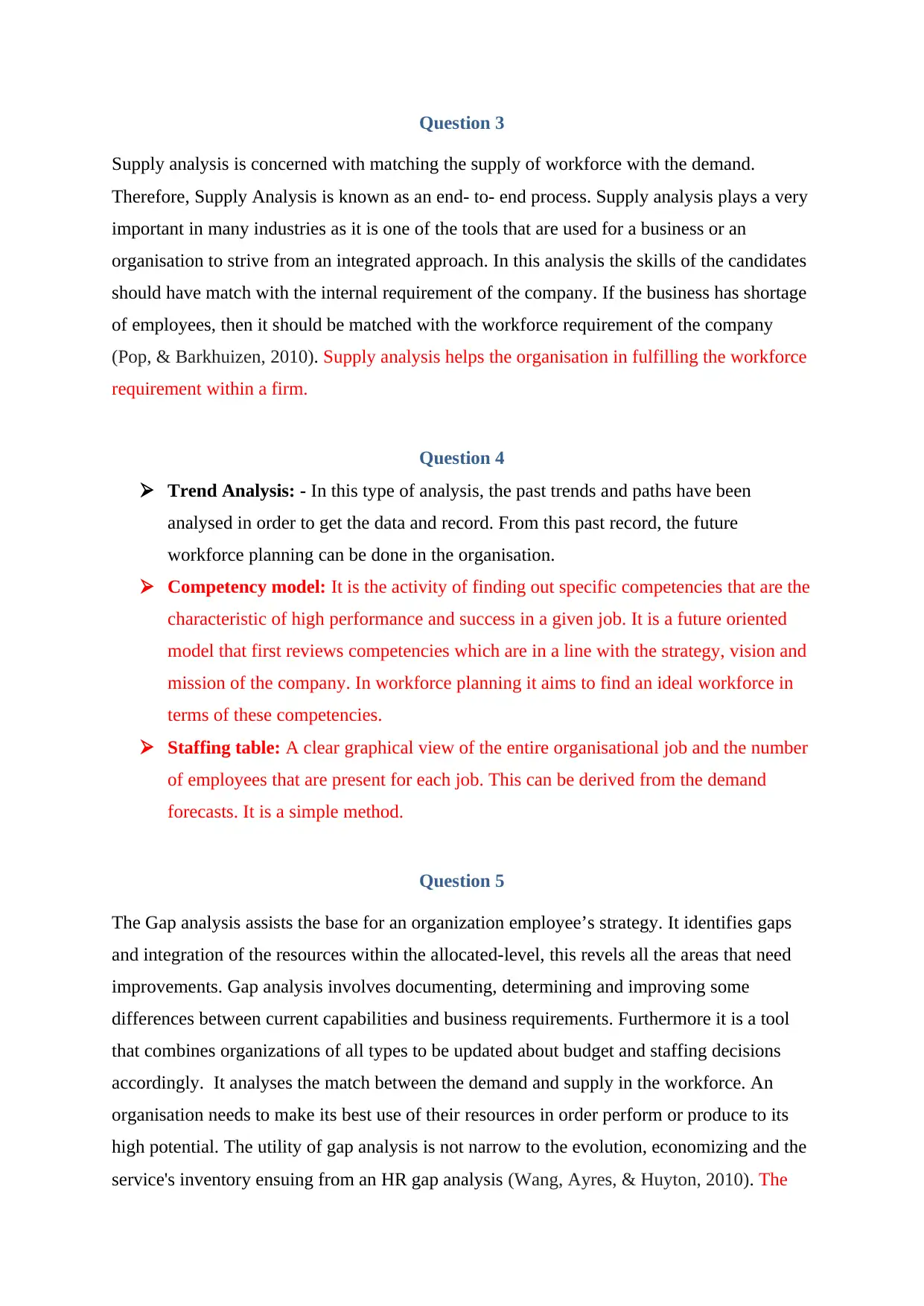
Question 3
Supply analysis is concerned with matching the supply of workforce with the demand.
Therefore, Supply Analysis is known as an end- to- end process. Supply analysis plays a very
important in many industries as it is one of the tools that are used for a business or an
organisation to strive from an integrated approach. In this analysis the skills of the candidates
should have match with the internal requirement of the company. If the business has shortage
of employees, then it should be matched with the workforce requirement of the company
(Pop, & Barkhuizen, 2010). Supply analysis helps the organisation in fulfilling the workforce
requirement within a firm.
Question 4
Trend Analysis: - In this type of analysis, the past trends and paths have been
analysed in order to get the data and record. From this past record, the future
workforce planning can be done in the organisation.
Competency model: It is the activity of finding out specific competencies that are the
characteristic of high performance and success in a given job. It is a future oriented
model that first reviews competencies which are in a line with the strategy, vision and
mission of the company. In workforce planning it aims to find an ideal workforce in
terms of these competencies.
Staffing table: A clear graphical view of the entire organisational job and the number
of employees that are present for each job. This can be derived from the demand
forecasts. It is a simple method.
Question 5
The Gap analysis assists the base for an organization employee’s strategy. It identifies gaps
and integration of the resources within the allocated-level, this revels all the areas that need
improvements. Gap analysis involves documenting, determining and improving some
differences between current capabilities and business requirements. Furthermore it is a tool
that combines organizations of all types to be updated about budget and staffing decisions
accordingly. It analyses the match between the demand and supply in the workforce. An
organisation needs to make its best use of their resources in order perform or produce to its
high potential. The utility of gap analysis is not narrow to the evolution, economizing and the
service's inventory ensuing from an HR gap analysis (Wang, Ayres, & Huyton, 2010). The
Supply analysis is concerned with matching the supply of workforce with the demand.
Therefore, Supply Analysis is known as an end- to- end process. Supply analysis plays a very
important in many industries as it is one of the tools that are used for a business or an
organisation to strive from an integrated approach. In this analysis the skills of the candidates
should have match with the internal requirement of the company. If the business has shortage
of employees, then it should be matched with the workforce requirement of the company
(Pop, & Barkhuizen, 2010). Supply analysis helps the organisation in fulfilling the workforce
requirement within a firm.
Question 4
Trend Analysis: - In this type of analysis, the past trends and paths have been
analysed in order to get the data and record. From this past record, the future
workforce planning can be done in the organisation.
Competency model: It is the activity of finding out specific competencies that are the
characteristic of high performance and success in a given job. It is a future oriented
model that first reviews competencies which are in a line with the strategy, vision and
mission of the company. In workforce planning it aims to find an ideal workforce in
terms of these competencies.
Staffing table: A clear graphical view of the entire organisational job and the number
of employees that are present for each job. This can be derived from the demand
forecasts. It is a simple method.
Question 5
The Gap analysis assists the base for an organization employee’s strategy. It identifies gaps
and integration of the resources within the allocated-level, this revels all the areas that need
improvements. Gap analysis involves documenting, determining and improving some
differences between current capabilities and business requirements. Furthermore it is a tool
that combines organizations of all types to be updated about budget and staffing decisions
accordingly. It analyses the match between the demand and supply in the workforce. An
organisation needs to make its best use of their resources in order perform or produce to its
high potential. The utility of gap analysis is not narrow to the evolution, economizing and the
service's inventory ensuing from an HR gap analysis (Wang, Ayres, & Huyton, 2010). The
Paraphrase This Document
Need a fresh take? Get an instant paraphrase of this document with our AI Paraphraser
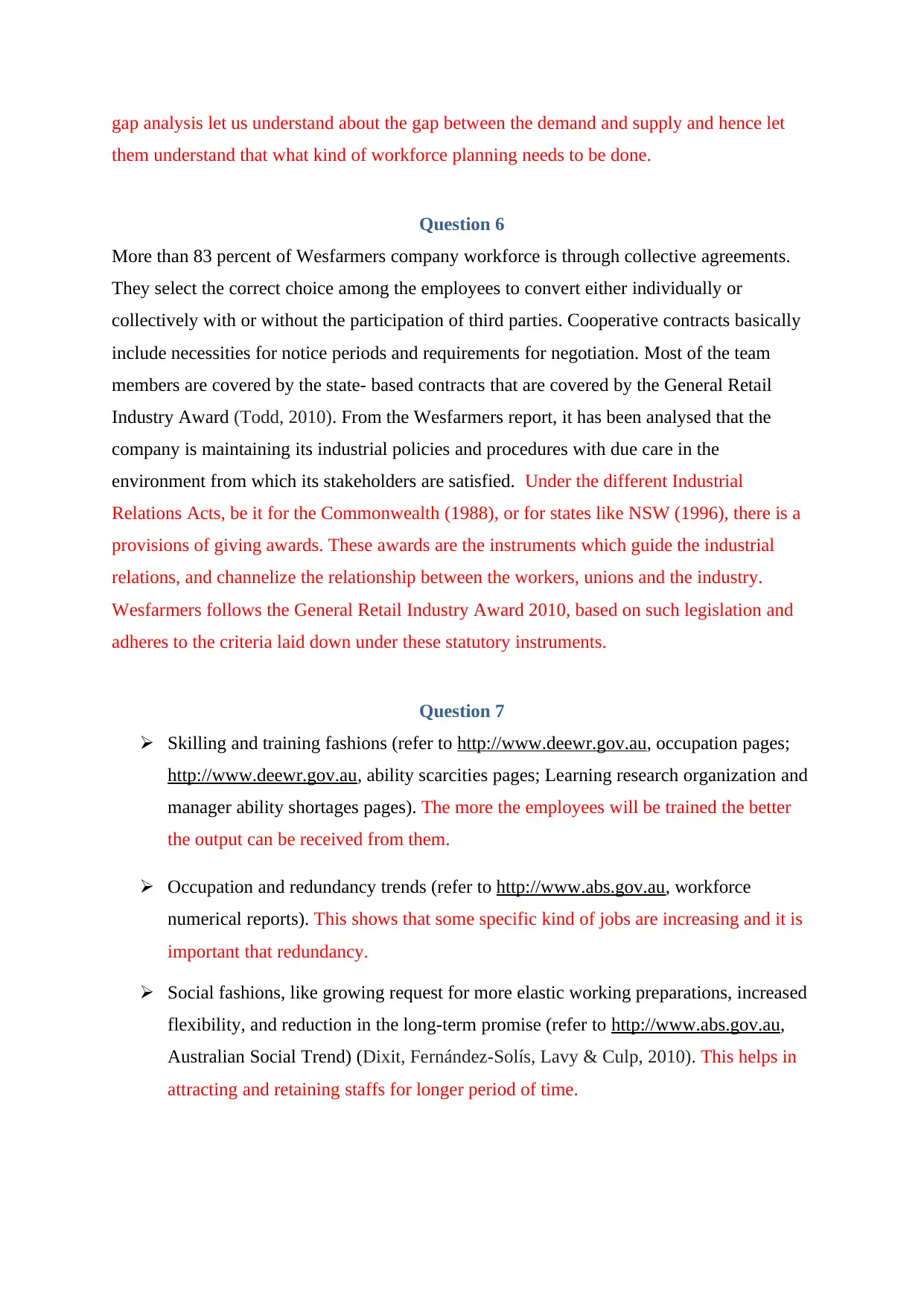
gap analysis let us understand about the gap between the demand and supply and hence let
them understand that what kind of workforce planning needs to be done.
Question 6
More than 83 percent of Wesfarmers company workforce is through collective agreements.
They select the correct choice among the employees to convert either individually or
collectively with or without the participation of third parties. Cooperative contracts basically
include necessities for notice periods and requirements for negotiation. Most of the team
members are covered by the state- based contracts that are covered by the General Retail
Industry Award (Todd, 2010). From the Wesfarmers report, it has been analysed that the
company is maintaining its industrial policies and procedures with due care in the
environment from which its stakeholders are satisfied. Under the different Industrial
Relations Acts, be it for the Commonwealth (1988), or for states like NSW (1996), there is a
provisions of giving awards. These awards are the instruments which guide the industrial
relations, and channelize the relationship between the workers, unions and the industry.
Wesfarmers follows the General Retail Industry Award 2010, based on such legislation and
adheres to the criteria laid down under these statutory instruments.
Question 7
Skilling and training fashions (refer to http://www.deewr.gov.au, occupation pages;
http://www.deewr.gov.au, ability scarcities pages; Learning research organization and
manager ability shortages pages). The more the employees will be trained the better
the output can be received from them.
Occupation and redundancy trends (refer to http://www.abs.gov.au, workforce
numerical reports). This shows that some specific kind of jobs are increasing and it is
important that redundancy.
Social fashions, like growing request for more elastic working preparations, increased
flexibility, and reduction in the long-term promise (refer to http://www.abs.gov.au,
Australian Social Trend) (Dixit, Fernández-Solís, Lavy & Culp, 2010). This helps in
attracting and retaining staffs for longer period of time.
them understand that what kind of workforce planning needs to be done.
Question 6
More than 83 percent of Wesfarmers company workforce is through collective agreements.
They select the correct choice among the employees to convert either individually or
collectively with or without the participation of third parties. Cooperative contracts basically
include necessities for notice periods and requirements for negotiation. Most of the team
members are covered by the state- based contracts that are covered by the General Retail
Industry Award (Todd, 2010). From the Wesfarmers report, it has been analysed that the
company is maintaining its industrial policies and procedures with due care in the
environment from which its stakeholders are satisfied. Under the different Industrial
Relations Acts, be it for the Commonwealth (1988), or for states like NSW (1996), there is a
provisions of giving awards. These awards are the instruments which guide the industrial
relations, and channelize the relationship between the workers, unions and the industry.
Wesfarmers follows the General Retail Industry Award 2010, based on such legislation and
adheres to the criteria laid down under these statutory instruments.
Question 7
Skilling and training fashions (refer to http://www.deewr.gov.au, occupation pages;
http://www.deewr.gov.au, ability scarcities pages; Learning research organization and
manager ability shortages pages). The more the employees will be trained the better
the output can be received from them.
Occupation and redundancy trends (refer to http://www.abs.gov.au, workforce
numerical reports). This shows that some specific kind of jobs are increasing and it is
important that redundancy.
Social fashions, like growing request for more elastic working preparations, increased
flexibility, and reduction in the long-term promise (refer to http://www.abs.gov.au,
Australian Social Trend) (Dixit, Fernández-Solís, Lavy & Culp, 2010). This helps in
attracting and retaining staffs for longer period of time.
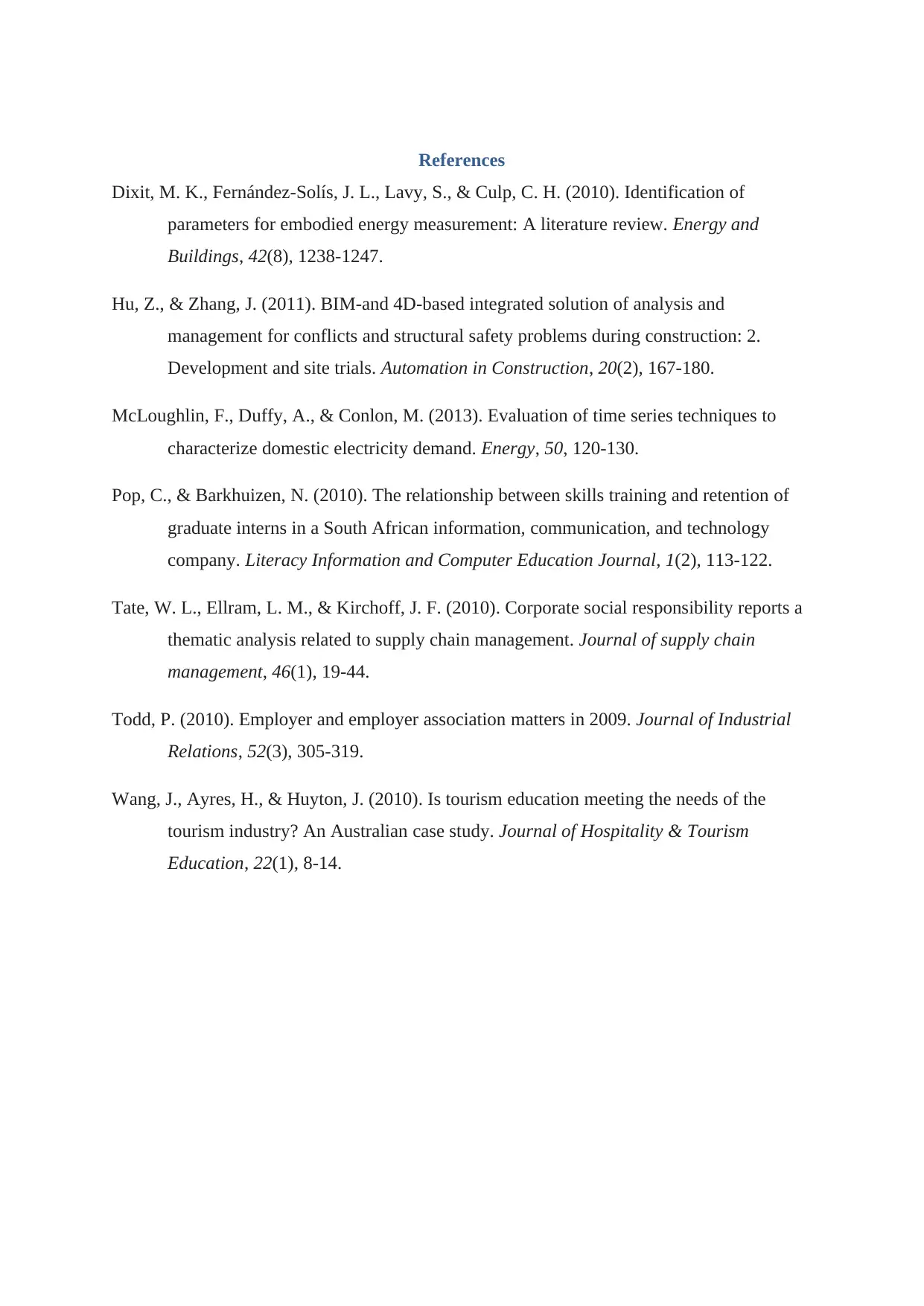
References
Dixit, M. K., Fernández-Solís, J. L., Lavy, S., & Culp, C. H. (2010). Identification of
parameters for embodied energy measurement: A literature review. Energy and
Buildings, 42(8), 1238-1247.
Hu, Z., & Zhang, J. (2011). BIM-and 4D-based integrated solution of analysis and
management for conflicts and structural safety problems during construction: 2.
Development and site trials. Automation in Construction, 20(2), 167-180.
McLoughlin, F., Duffy, A., & Conlon, M. (2013). Evaluation of time series techniques to
characterize domestic electricity demand. Energy, 50, 120-130.
Pop, C., & Barkhuizen, N. (2010). The relationship between skills training and retention of
graduate interns in a South African information, communication, and technology
company. Literacy Information and Computer Education Journal, 1(2), 113-122.
Tate, W. L., Ellram, L. M., & Kirchoff, J. F. (2010). Corporate social responsibility reports a
thematic analysis related to supply chain management. Journal of supply chain
management, 46(1), 19-44.
Todd, P. (2010). Employer and employer association matters in 2009. Journal of Industrial
Relations, 52(3), 305-319.
Wang, J., Ayres, H., & Huyton, J. (2010). Is tourism education meeting the needs of the
tourism industry? An Australian case study. Journal of Hospitality & Tourism
Education, 22(1), 8-14.
Dixit, M. K., Fernández-Solís, J. L., Lavy, S., & Culp, C. H. (2010). Identification of
parameters for embodied energy measurement: A literature review. Energy and
Buildings, 42(8), 1238-1247.
Hu, Z., & Zhang, J. (2011). BIM-and 4D-based integrated solution of analysis and
management for conflicts and structural safety problems during construction: 2.
Development and site trials. Automation in Construction, 20(2), 167-180.
McLoughlin, F., Duffy, A., & Conlon, M. (2013). Evaluation of time series techniques to
characterize domestic electricity demand. Energy, 50, 120-130.
Pop, C., & Barkhuizen, N. (2010). The relationship between skills training and retention of
graduate interns in a South African information, communication, and technology
company. Literacy Information and Computer Education Journal, 1(2), 113-122.
Tate, W. L., Ellram, L. M., & Kirchoff, J. F. (2010). Corporate social responsibility reports a
thematic analysis related to supply chain management. Journal of supply chain
management, 46(1), 19-44.
Todd, P. (2010). Employer and employer association matters in 2009. Journal of Industrial
Relations, 52(3), 305-319.
Wang, J., Ayres, H., & Huyton, J. (2010). Is tourism education meeting the needs of the
tourism industry? An Australian case study. Journal of Hospitality & Tourism
Education, 22(1), 8-14.
⊘ This is a preview!⊘
Do you want full access?
Subscribe today to unlock all pages.

Trusted by 1+ million students worldwide
1 out of 6
Related Documents
Your All-in-One AI-Powered Toolkit for Academic Success.
+13062052269
info@desklib.com
Available 24*7 on WhatsApp / Email
![[object Object]](/_next/static/media/star-bottom.7253800d.svg)
Unlock your academic potential
Copyright © 2020–2025 A2Z Services. All Rights Reserved. Developed and managed by ZUCOL.




